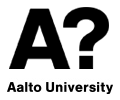Photo: A. Mityakov
THERAD project is an Academy of Finland funded consortium project which is a part of the RADDESS program granted in Nov. 2017.
https://www.youtube.com/watch?v=2g1D1WVk3SQ
ABSTRACT
THERAD research aims at creating a new fire detection and measurement technology by combining gradient heat flux sensors (GHFS) with novel spectrally selective coatings into robust, low-weight and low-cost thermal radiation sensors. GHFS are based on the transverse Seebeck effect in anisotropic materials and generate thermopower proportional to the heat flux. First we will design the coating systems by computing the localized surface plasmon resonances on low-bandcap semiconductor particles. For spherical particles, we will use Mie theory for the absorption and scattering cross sections, followed by Monte Carlo simulations for the coating transmittance. The boundary conditions for the design calculations will be taken from narrow-band radiation solution (RADCAL) of combustion products. Next, we will investigate the suitability of sol-gel and pulsed electric current sintering (PECS) manufacturing techniques for making the micro- and nanoparticle inclusions in thin coating layers to implement infrared bandpass filters. Finally, coated sensors will be optimized and calibrated for the use in flame detection and measurement problems, and validated using experimental (ISO 5660) and computational methods.
RESEARCH PARTNERS
There are four research groups involved in this project as followings:
- The Fire Safety Engineering research group, Professor Simo Hostikka, Department of Civil Engineering, School of Engineering, Aalto University, Finland.
- Laboratory of Control Engineering and Digital Systems, Professor Andrey Mityakov, Lappeenranta University of Technology, Finland.
- Laboratory of Multiscale Statistical Physics (MSP), Professor Tapio Ala-Nissilä, School of Science, Aalto University, Finland.
- Laboratory of Advanced and Functional Materials (AFM), Professor Simo-Pekka Hannula, School of Chemical Engineering, Aalto University, Finland.
PUBLICATIONS AND PRESENTATIONS
- Alinejad, F., Bordbar, S., Hostikka, S. Improving the modelling of spectral radiation penetration into the condensed materials with the separated full spectrum correlated-k method. International Journal of Heat and Mass Transfer, 176: 121448. 2021. https://doi.org/10.1016/j.ijheatmasstransfer.2021.121448
- Alinejad, F., Bordbar, S., Hostikka, S. The ordinate weighting method for solving radiative heat transfer through a Fresnel interface. Journal of Quantitative Spectroscopy & Radiative Transfer, 270:107685. 2021. https://doi.org/10.1016/j.jqsrt.2021.107685
- Bordbar, H., Coelho, F.R., Fraga, G.C., França, F.H.R., Pressure-dependent weighted-sum-of-gray-gases models for heterogeneous CO2 – H2O mixtures at sub- and super-atmospheric pressure. International Journal of Heat and Mass Transfer, 173:121207. 2021. https://doi.org/10.1016/j.ijheatmasstransfer.2021.121207
- Bordbar, H., Hostikka, S., Boulet, P., Parent, G. Numerically resolved line by line radiation spectrum of large kerosene pool fires. Journal of Quantitative Spectroscopy and Radiative Transfer, 2020. 254:107229. https://doi.org/10.1016/j.jqsrt.2020.107229
- Alinejad, F., Bordbar, H., Hostikka, S. Development of full spectrum correlated k-model for spectral radiation penetration within liquid fuels. International Journal of Heat and Mass Transfer, 2020. 158:119990. https://doi.org/10.1016/j.ijheatmasstransfer.2020.119990
- Bordbar, H., Fraga, G.C., Hostikka, S. An extended weighted-sum-of-gray-gases model to account for all CO2‐H2O molar fraction ratios in thermal radiation. International Communications in Heat and Mass Transfer 110 (2020). 104400. https://doi.org/10.1016/j.icheatmasstransfer.2019.104400
- Seyedheydari, Fahime; Conley, Kevin; Ala-Nissila, Tapio. 2020. “Near-IR Plasmons in Micro and Nanoparticles with a Semiconductor Core.” Photonics 7, no. 1: 10. https://doi.org/10.3390/photonics7010010
- Bordbar H., Hostikka S., Numerical Solution of LBL Spectral Radiation of a Heptane Pool Fire, The proceeding of the 9th International Symposium on Radiative Transfer, RAD-19, in Athens, Greece, 3 – 7 June 2019, Begellhouse publication, pages 57-64 DOI: 10.1615/RAD-19.80.
- Bordbar H., Hostikka S., Detailed computation of radiation spectra in pool fires, Poster in 9th International Seminar on Fire and Explosion Hazards, in Saint-Petersburg, 21−26 April 2019.
- Darbandi M. , Barezban M. B., Fatin A.,Bordbar H., Effect of Oxygen Enrichment in Spectral Thermal Radiation in an Unconfined Turbulent Bluff-Body Flame, The proceeding of the 9th International Symposium on Radiative Transfer, RAD-19, in Athens, Greece, 3 – 7 June 2019.
- Bordbar H., Hostikka S., Boulet P., Parent G. , Erez G., Numerically Solved Flame Spectra of a n-Heptane Pool Fire, in proceeding of the 15th International Conference and Exhibition on Fire Science and Engineering (Interflam 2019), in London, UK, 1-3 July 2019.
- Isojärvi, T., Bordbar, H., Hostikka, S., “Calculation of radiation transmittance through n-heptane in a pool fire”, Journal of Physics: Conference Series, Vol. 1107, p. 042002, (2018). doi :10.1088/1742-6596/1107/4/042002
- Bordbar H., Fraga G.C., Hostikka S., “An Extended Weighted-Sum-of-Gray-Gases Model to Account for All CO2-H2O Molar Fraction Ratios in Thermal Radiation”, International Communications in Heat and Mass Transfer, Vol. 110, pp. 104400, (2020). https://doi.org/10.1016/j.icheatmasstransfer.2019.104400.
- Fraga G.C., Bordbar H., Hostikka S., Franҫa, F.H.R., High-Fidelity Numerical Data for Non-Gray Radiative Transfer in Three-Dimensional Benchmarks Using Line-by-Line Integration, Journal of Heat Transfer T-ASME, Vol. 142(3), pp. 034501. https://doi.org/10.1115/1.4045666 .
- Isojärvi T., Bordbar H., Hostikka S., “Spectrally resolved calculation of thermal radiation penetration into liquid n-heptane in pool fires”, International Journal of Heat and Mass Transfer, Vol 127, pp. 1101–1109, (2018). Link.
- Isojärvi T., Bordbar H., Hostikka S., “Radiative heat transfer in pool fires”, Nordic Fire and Safety Days 2018, June 2018, Trondheim, Norway.
- Isojärvi T., Bordbar H., Hostikka S., “Calculation of radiation transmittance through n-heptane in a pool fire”, European symposium on fire safety sciences (ESFSS2018), Sep. 2018, Nancy, France.
- Conley K., Thakore V., Ala-Nissila T., Plasmonically Enhanced Spectrally-Sensitive Coatings for Gradient Heat Flux Sensors, 2018 Progress In Electromagnetics Research Symposium (PIERS | Toyama), Japan, 1-4 August, 2018.


